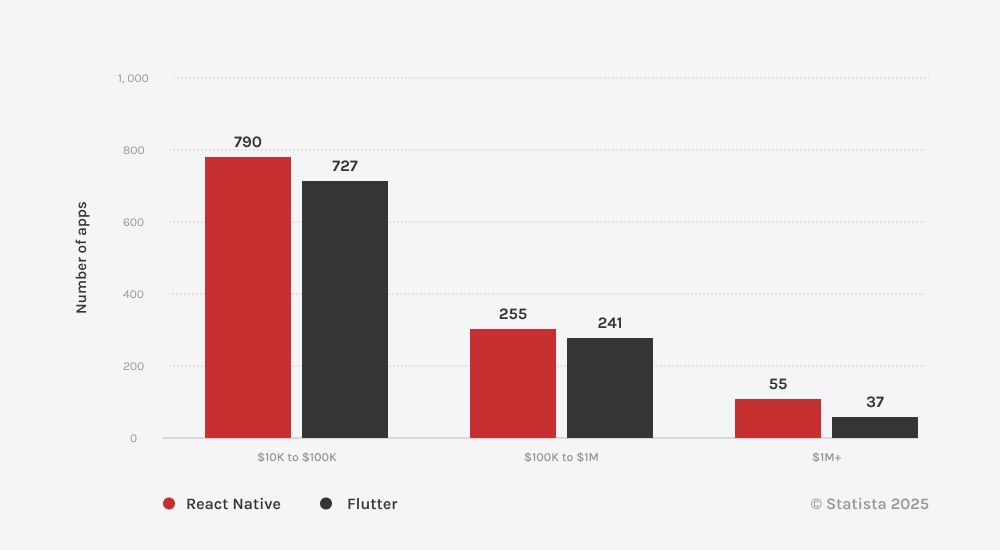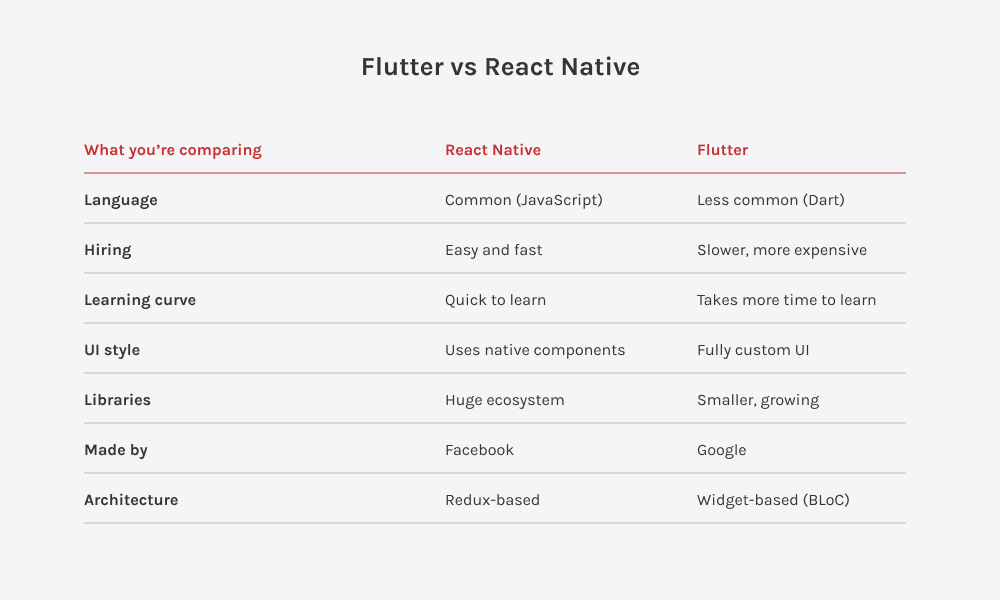Your message has been sent.
We’ll process your request and contact you back as soon as possible.
The form has been successfully submitted.
Please find further information in your mailbox.



After leading mobile strategy across dozens of product launches, I’ve lost count of how many times the Flutter vs React Native debate has come up. Cross-platform development usually cuts costs by 15–20% compared to building two separate native apps. But cost alone doesn’t decide which one’s right for you. The real difference between Flutter and React Native lies in how well each one fits your business goals — team skillset, launch timeline, long-term maintenance, etc. So let’s look at the comparison through that lens: practical, strategic, and focused on outcomes that matter.
Flutter and React Native are the two leading frameworks for cross-platform mobile development. Both let you build Android and iOS apps from a single codebase and are backed by major players — Google and Meta. In this Flutter vs React Native comparison, I’ll break down the real differences between them: how they affect launch speed, development costs, user experience, scalability, and long-term support for web, desktop, and beyond.
If speed is a top priority — and let’s face it, it usually is — Flutter gives you an advantage. Thanks to Hot Reload and its rich widget library, developers can test changes on the fly and move fast without constantly rebuilding. In addition, the ability to use a single codebase across Android, iOS, web, and more saves a lot of time.
React Native is also fast, especially if your team already knows JavaScript and React. Its Fast Refresh tool and wide range of pre-made components help speed things up. However, making the app look and feel exactly the same on both platforms can take extra time, which might slow things down a bit.
Key takeaway: Flutter wins for speed.
Now, let’s talk about money. Flutter covers mobile, web, desktop, and even embedded platforms with one codebase, which saves time and money right out of the gate. You also deal with fewer third-party dependencies, meaning less technical debt and simpler updates.
React Native helps cut costs too, especially if you’re only building for mobile. But in practice, you’ll often need to write custom native modules to get full access to device features or hit the performance you need — and that extra work can drive costs up.
Still, React Native holds its ground when it comes to results: as of October 2024, 790 apps built with React Native were earning between $10,000 and $100,000 a month, slightly more than the 727 Flutter apps in the same range. So while Flutter can be more predictable cost-wise across platforms, React Native’s added effort can pay off if mobile is your main market.
Key takeaway: Neck and neck here, but React Native edges it for mobile development.

If your app needs to look and feel the same everywhere — which is expected for strong consumer brands — Flutter is better than React Native. It doesn’t rely on native UI components, instead, it renders everything itself, giving you full control over visuals and behavior across platforms. That’s ideal when consistency is non-negotiable.
On the flip side, React Native leverages native components, so your app feels more “at home” on both iOS and Android. That’s a big win for apps where platform familiarity improves usability. However, this also means that aligning your UX across devices may require more time and testing.
Key takeaway: Want a unified brand look? Go with Flutter. Prefer platform-native vibes? React Native is your friend.
Flutter makes it easy to launch an MVP quickly without giving up on good design. Built-in tools create smooth, modern interfaces, so you usually don’t have to dive into native code at the start. React Native is just as solid, especially for teams already familiar with React for web. Both frameworks let you move fast, but if your app needs deeper features like geolocation, camera access, or device sensors, you’ll probably still need some native development work — no matter which one you pick.
Key takeaway: Both frameworks get you to MVP fast. Just don’t expect to skip native code if your app’s doing more than the usual.
Let’s move on to enterprise-grade applications. React Native has been around longer and has a deeper ecosystem for native integrations. It’s often the safer bet for large-scale apps that demand platform-specific features or involve heavy lifting on the backend. That doesn’t mean Flutter can’t handle it. It’s evolving fast, and I’ve seen it work well in enterprise environments, especially when visual consistency and multi-platform reach are part of the roadmap. But for now, if you’re diving deep into custom integrations, React Native may give you more room to maneuver out of the box.
Key takeaway: React Native is a safer bet for enterprise apps with heavy native integrations.
Finally, we come to platform strategy. Both Flutter and React Native offer distinct strengths. Flutter was built for cross-platform development from day one. It runs on Android, iOS, web, desktop, and even embedded devices — all from a single codebase. If you need to launch across multiple platforms without juggling separate projects, Flutter handles that out of the box.
React Native focuses on mobile. You can extend it to the web with tools like React Native Web or Electron, but these projects are community-driven and not maintained to the same level as the core framework. That said, React Native’s web support has improved a lot and is getting more stable with every release. If you’re building a mobile-first app and plan to add a web version later, it’s now a real option.
Going beyond mobile and web with React Native — into desktop or embedded platforms — usually means using workarounds. These setups can get complicated and harder to maintain over time. Flutter’s built-in support for desktop and embedded can save time and reduce risk if you’re thinking long-term.
Key takeaway: Going wide? Flutter’s your tool. Sticking to mobile with plans to grow? React Native still fits the bill.
Picking the right app development framework can decide whether an app takes off or struggles to keep up. The best way to see what works? Look at the companies already using these frameworks to build powerful, high-performing apps. Some of the biggest brands have tapped into the React Native ecosystem or put their trust in Flutter to create seamless cross-platform experiences. Here’s how they made it happen.
Expanding an app to a new platform usually means rebuilding everything from scratch, but Facebook took a different route. When they needed to launch their Ads Manager app on Android, they didn’t start over. Instead, they reused around 85% of the code from the iOS version, thanks to React Native’s cross-platform capabilities. This helped them roll out the Android version faster, cut down development time, and keep the experience seamless across devices.
Similarly, Walmart had a massive app with millions of users, and rewriting it all at once wasn’t an option. Instead of scrapping their existing system, they introduced React Native gradually — testing it, rolling it out piece by piece, and replacing native components along the way. Eventually, nearly 90% of their grocery app ran on React Native. That move sped up updates, reduced development overhead, and created a better shopping experience without breaking what was already working. This is proof that even enterprise-level businesses can make the switch without unnecessary risks.
Meanwhile, BMW faced a common issue — managing two separate codebases for iOS and Android was slowing them down. Instead of constantly playing catch-up between platforms, they scrapped both and rebuilt everything in Flutter. The result? A single My BMW App, available in 47 countries, allows drivers to access key vehicle features from any device. By switching to Flutter, BMW cut down on maintenance time and focused on improving the app rather than fixing inconsistencies.
eBay Motors had a different challenge: they needed an app that could handle high traffic, real-time interactions, and secure transactions — all while remaining fast and responsive. With Flutter, they built a high-performance app loaded with features like live chat and secure payments, all from a single codebase. That meant faster development, smoother performance, and a native-like feel without the hassle of managing two separate platforms. For businesses looking to roll out new features quickly while keeping performance sharp, eBay Motors proves that Flutter is a strong choice.
Flutter and React Native have proven their value for companies that need to modernize fast without multiplying overhead. A single codebase means fewer integration points, faster rollouts, and tighter control over app behavior across platforms. In our experience, this approach cuts time-to-market and simplifies long-term maintenance. The results speak for themselves — just look at how Facebook, Walmart, BMW, and eBay Motors have used cross-platform frameworks as a lever for scale.

CTO at Innowise
Choosing the right framework means thinking beyond short-term performance. The Flutter vs React Native future is unfolding fast, with each framework taking a different path in the cross-platform space. Where they’re headed matters, because that direction will shape how your product evolves and scales over time.
One of the biggest strategic differentiators in the Flutter vs React Native comparison is Flutter’s direct backing by Google. And let’s be honest — having one of the world’s biggest tech giants in your corner is no small thing. Flutter is evolving into a comprehensive UI toolkit for everything from mobile to web, desktop, and embedded devices.
Google’s long-term commitment, reflected in constant updates to the Dart language and the rollout of the Impeller rendering engine, signals that they’re in this for the long haul. Using one codebase for multiple platforms without losing performance can give teams a real edge in the long run.
Here’s the million-dollar question: Is Flutter going to replace React Native in 2025? In tech, nothing stays the same for long, and things are starting to shift. React Native still holds the crown in terms of developer base and production-scale adoption. Backed by Meta and deeply embedded in the JavaScript ecosystem, it remains a dominant force, particularly for mobile-first development. Plus, recent upgrades like the Bridgeless New Architecture and JSI have helped React Native patch up some long-standing performance gaps.
And what about Flutter? It’s been quietly climbing the ladder, winning over dev teams and product owners with its beautiful UIs, predictable rendering, and multi-platform reach. Google’s vision for Flutter is crystal clear — and it’s broader than mobile. So, will one replace the other? Probably not overnight. But in the broader Flutter vs React Native future discussion, Flutter is gaining serious ground.
According to a 2023 developer survey, Flutter is the most popular cross-platform mobile framework among global developers. So, whether you’re chasing innovation or just want a solid return on your tech investment, Flutter and React Native each have their merits, and it’s just a matter of which one fits your roadmap. In the end, it’s not about which one wins — it’s about which one works better for your project.
One of the biggest questions in the Flutter vs React Native comparison is this: which one plays nicer with the tools and platforms your business already uses? If you’re building modern apps, chances are you’re also working with third-party APIs, back-end systems like Firebase or AWS, and possibly even exploring AI, IoT, or AR. So before choosing between Flutter or React Native, it’s worth digging into how each framework fits into the bigger tech picture.
If your stack includes Firebase, AWS, or whatsoever, you’ll want to look closely at how both frameworks handle back-end integration. React Native often has an advantage in this area, especially if your team already works with JavaScript. Thanks to its wide adoption and long-standing community, it connects easily with back-end tools like Firebase Auth, Firestore, and AWS Amplify. Many of these libraries were built with React Native in mind from the get-go. So if your team’s already familiar with JS-based tooling, React Native makes it easy to plug into existing infrastructure without reinventing the wheel.
Flutter, on the other hand, uses Dart, which isn’t as universally supported, but that doesn’t mean it’s lacking. With FlutterFire, the official set of Firebase plugins for Flutter, you get first-class support for Firebase features. It’s mature, well-documented, and more than enough for most app needs. AWS integrations with Flutter require a bit more legwork, but they’re very doable. You’ll just need to rely more on community packages or custom wrappers in some cases.
If you’re deciding between Flutter or React Native for backend-heavy apps, consider your current stack. React Native offers a faster lift-off if you’re already in the JavaScript world. But if you’re starting fresh, Flutter holds its ground — especially with Firebase.
Now let’s talk about future tech. AI, AR, and IoT are becoming standard in modern apps — so how do Flutter and React Native handle them? React Native has the advantage of a massive ecosystem. Need voice recognition, AR modules, or device sensors? There’s probably a package — or ten — ready to go. React Native’s tight ties to JavaScript and native modules give it flexibility here. Integrating TensorFlow.js, ARKit via native bridges, or Bluetooth-connected IoT devices is fairly straightforward once you get the hang of it.
Flutter, while a bit newer in this space, has been picking up speed. You’ll find solid packages for AR (like ar_flutter_plugin), computer vision, and real-time data streaming. It also gives you better control over the rendering layer, which can come in handy for visual-heavy experiences like AR. Flutter’s performance is often more consistent, especially when animations or high frame rates matter. In short, both Flutter and React Native are up to the task, but they get there in different ways. React Native relies more on existing tools and libraries, while Flutter gives you more control over performance and how your app looks and feels.
So if you’re weighing the difference between Flutter and React Native in terms of integrating cutting-edge features, your choice depends on your priorities: speed of integration vs performance control.
The real-world challenge often starts with finding the right people to build and scale your product. The availability of developers and the depth of expertise in each framework can directly impact hiring timelines, team structure, and your overall project costs. In the ongoing Flutter vs React Native comparison, this factor is often underestimated, yet it’s one of the most decisive.
The React Native ecosystem has been growing steadily since 2015 and benefits from a global developer base fluent in JavaScript. React Native is built on technology most front-end developers already know. Because of this, companies can often bring in talent more quickly and scale teams without much friction. If you’re hiring for a React Native app, chances are you’ll have access to a wide pool of candidates at competitive rates.
In contrast, Flutter, powered by the Dart language, entered the scene in 2018 with a different approach. Dart is fast and expressive, but not as commonly used as JavaScript. This leads to a smaller developer pool. Finding qualified Flutter engineers can take longer, and salaries might run higher due to demand outpacing supply in many regions. Still, Flutter is gaining traction, and its popularity is rising with every major release.
If speed and ease of hiring are top priorities, React Native often offers a more predictable path. Whereas, for organizations building dedicated cross-platform teams from scratch, Flutter presents an opportunity to invest early in a growing, modern stack that many developers are eager to learn.
When building a team beyond just one or two engineers, the difference between Flutter and React Native becomes more pronounced. React Native offers broad access to third-party tools, plugins, and UI kits. This shortens development timelines and helps reduce the overhead of building everything from scratch. Teams can also integrate native code when needed, making it easier to add custom features or incorporate native UI components.
On the other hand, Flutter gives development teams something React Native doesn’t — full control over the UI across platforms. Rather than relying on the system’s own components, Flutter draws everything from scratch. This allows for greater design consistency and fewer surprises across iOS and Android. While the initial developer cost might be higher, the unified codebase often reduces long-term maintenance and simplifies updates. Flutter’s built-in widgets and architecture make it a solid choice for projects that prioritize a consistent visual experience and multi-platform rollout.
From a cost perspective, Flutter and React Native both have advantages — React Native for faster onboarding and early velocity, Flutter for longer-term efficiency when targeting multiple platforms beyond mobile.
Each framework supports teams with different levels of experience. React Native is especially well-suited to developers with a background in JavaScript or React. For companies with existing web teams, the transition to React Native is usually straightforward. The syntax is familiar, and the learning curve is gentle.
Conversely, Flutter appeals to teams looking for tight design control and a structured development model. Its widget-based approach and comprehensive tooling allow both junior and senior developers to build robust apps without needing to dive into native code. Teams new to mobile development can quickly pick up Dart and start building performant apps with less platform-specific complexity.

I’ve led enough mobile app development projects to know things rarely go as planned. Features change, deadlines shift, and stable builds can break in production. That’s why, in the Flutter vs. React Native debate, I look beyond surface-level features and focus on how each framework holds up when things get complex.
React Native is fast and flexible, with a strong community and deep JavaScript roots. But that flexibility often depends on third-party libraries, which can become a liability. Outdated packages, abandoned plugins, and disappearing tools are all too common. To avoid chaos, we set up guardrails: auditing dependencies, avoiding under-supported tools, and wrapping critical features in fallback logic. React Native works well for complex apps, but it takes discipline to keep things stable.
Flutter, by contrast, comes with more out-of-the-box support. Most UI components, animations, and navigation tools are built-in and backed by Google. That reduces reliance on external packages and cuts down the risk of version conflicts. It’s generally more predictable, but once you go beyond the basics, native integrations and edge cases still require solid planning.
Ultimately, it’s not about which framework is safer. It’s about how your team handles risk. With the right architecture and process, both Flutter and React Native can support complex, real-world apps without falling apart.
Do you need to launch fast with limited resources? → React Native
Are you investing in multi-platform support long-term? → Flutter
Is the app standard mobile (iOS + Android) with no heavy UI needs? → Both
Do you need consistent design and rich animations across platforms? → Flutter
Does your team already use JavaScript or React? → React Native
Are you building a new team or outsourcing development? → Flutter
Will the app scale fast and need frequent updates? → React Native
Do you want fewer external dependencies over time? → Flutter
Technology choices shape more than just code, in fact, they define how your product scales, how your team grows, and how fast you can adapt. When evaluating the difference between Flutter and React Native, think beyond benchmarks. Hiring, maintenance, and platform strategy all matter. We’ve seen teams switch mid-project — not because they picked the wrong tech, but because it didn’t match their long-term needs. Choose the framework that fits your team, your goals, and your roadmap. That’s how you build something that lasts — not just something that launches.

Head of Mobile Department
Eugene drives our mobile vision with a sharp eye on performance, usability, and future-proof tech. He helps businesses turn big ideas into fast, intuitive apps that people actually want to use.












Your message has been sent.
We’ll process your request and contact you back as soon as possible.

By signing up you agree to our Privacy Policy, including the use of cookies and transfer of your personal information.